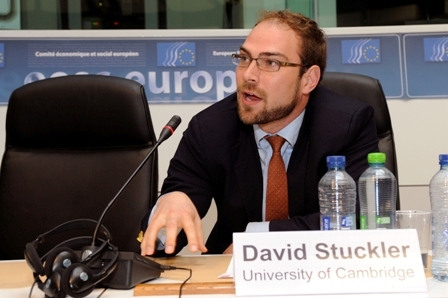David Stuckler on Austerity and Death
You might assume that deaths increase in a recession, but that doesn’t necessarily happen. What is clear, however, is the relation between government austerity responses to recession and an increase in rates of death. University of Oxford sociologist David Stuckler, recently named one of Foreign Policy‘s Leading Global Thinkers for 2013, explains in this episode of the Social Science Bites podcast. Stuckler and economist Sanjay Basu’s recent book, The Body Economic: Why Austerity Kills, was called “a powerful indictment of the unnecessary suffering and rising mortality rates associated with austerity policies unsoftened by remedial social programmes,” by The Financial Times‘ Harry Eyres.
Social Science Bites is made in association with SAGE.
To directly download this podcast, right click HERE and “Save Link As.”
Click HERE to download a PDF transcript of this conversation. The full text also appears below. Liked this episode? Rate our show on iTunes
***
David Edmonds: If someone claimed that recessions usually result in an increase in the death rate, well, you probably wouldn’t be surprised. But David Stuckler, a sociologist and epidemiologist at the University of Oxford, says that the relationship isn’t that simple. What is clear, though, he argues, is the link between death and government austerity programmes.
Nigel Warburton: David Stuckler, welcome to Social Science Bites.
David Stuckler: It’s a pleasure to join you.
Nigel Warburton: The topic we’re going to focus on is ‘Austerity and Death’. What is the connection between austerity and death?
David Stuckler: We’ve been studying how recessions and economic catastrophes can literally get under people’s skin to affect their health and wellbeing, looking at data from the Great Depression to the Asian financial crisis in the nineties, straight through to the present recessions. And what we’ve learned is that recessions can hurt, but austerity kills.
NW: Ok, so you’re making a distinction between recession and the response to recession. Let’s take recessions first. So recessions throughout history have had negative effects on people’s health?
DS: It may come as a surprise for those who have learned about the Great Depression, like I did, through images of bankers jumping out of windows, to know that even though in recession suicides tend to rise, overall historically they’ve tended to correlate with reductions in mortality rates. In the Great Depression of the 1930s, mortality rates fell by about ten percent.
Had austerity been organized like a drug trial, with a board of ethics, it would have been discontinued, given evidence of its deadly side-effects and the failure of its purported economic benefits to accrue.
NW: So is there something about a recession that makes people less likely to die?
DS: Turning to history, with the Great Depression, it was a complex period; there was a lot of epidemiological and health change going on at the time. When we drilled into the data, what we found is that there were rises in suicides concentrated in the parts of the United States that had worse economic crises, but road traffic deaths tended to fall, plausibly, as people drove less. In the first time in the history of the car, automobile sales dropped. It played such a major role that it outweighed the suicide rises. That’s a pattern we’ve seen happen now in the present – two years ago in the US, road traffic deaths hit a 60-year low. The same happened across Europe: where crises have been greater, road traffic deaths have fallen more.
NW: Well, recessions can be surprising, obviously, from what they’re correlated with, from what you’re saying, and it’s quite a complex series of cause and effect going on there. But what about the response of austerity to recession, something we’re seeing a lot over Europe and beyond?
DS: This turns back to the Great Depression, as well. One of the key turning points was the debate around whether to boost or decrease social spending. And in the US, President Roosevelt campaigned on the platform of a ‘New Deal’, massively expanding relief to the newly unemployed; instituting public works programs to build hospitals and schools and chart the US on a better financial track for the future. And it created a natural experiment across US states because some governors, particularly right-wing ones, sought to avoid the New Deal altogether, whereas others – such as Huey Long in Louisiana, a left-wing governor – thought Roosevelt didn’t go far enough. And we were able to use this variation to identify over time that the state governors that introduced more relief spending in the New Deal had greater improvements in child morality; reductions in tuberculosis, whooping cough and other prevalent diseases at the time.
NW: These findings about the Great Depression in America, though, they’re about a different world situation. It’s before the Internet; it’s before certain sorts of trade routes have opened up. Can you make a move from historical analysis to understanding the present situation and the likely effects of austerity?
DS: In terms of recession, we see history repeating itself. So, in Europe suicides have been declining prior to the recession and coinciding with a large increase in job losses and the aftermath of the bursting of the housing bubble. We’ve seen suicides rise; in Europe, we’ve estimated there have been almost eight thousand suicides over and above historical trends; in North America there have been around five thousand excess suicides. In parallel, road traffic deaths have tended to fall. So we do see some plausible empirical regularities that play out. Austerity is the real danger. In countries making some of the deepest cuts in Europe, we see effects that are coinciding not with the timing of the recession but deep cuts. In Greece, for example, the country is in the middle of a public health disaster. To meet budget deficit reduction targets set by the Troika – the conglomeration of the European Central Bank; European commission International Monetary Fund – it cut its health sector by 40 percent. HIV infections have doubled, as prevention programs are slashed. When programs to spray for mosquitoes were cut in the southern part of the country, there was a return of malaria which had been previously eradicated since the early 1970s. And I could go on – from panic in pharmacies, some drugs have been stocked on shelves – to a rise in infant mortality by 40 percent in the past several years.
NW: It might be fair to say that the situation in Greece is one of hyper-austerity. But just moderate austerity – the kind we’re seeing in Britain, for instance – is that really causing an impact that results in deaths?
DS: We hear news stories, for example, of bedroom tax suicides; one case was Miss Stephanie Bottrill who, under the ‘bedroom tax’ – an austerity measure introduced by the government to reduce deficits – she had to increase spending of 25 percent to make rent payments because she had an emptied room. She had raised her daughters for 18 years in her house but was no longer able to afford it under the policy changes and on the day she was set to be evicted, she packed up her bags and – at the moment of moving out – threw herself in front of a lorry. Her tragedy is one of more than a thousand we’ve seen in the UK corresponding to where we’ve seen greater rises in unemployment and housing payment problems.
NW: So you’re suggesting that it’s austerity that is the catalyst for suicides like that, not the increasing impact of the recession?
DS: The UK’s an interesting case because it’s had two waves of suicide often tracking with patterns of unemployment. The first, when there was a large burst and then job losses around the time of recession in step, particularly in men there is a spike in suicides. That began to drop down again as employment rebounded. Then the transition to the coalition government, as austerity measures took effect, there were big cuts in public sector employment, this time dispersed across the country and that created a new map of suicidality and increased rates of depression across the country.
NW: What kind of scale are we talking about here? Countries that have imposed austerity: what kind of increase in mortality has resulted?
DS: Looking at overall death rates paints a misleading picture of the health status of a population. Life expectancy has tended to continue to improve apart from the counter-intuitive benefits from reductions in road deaths. This has been the basis for some commentators to say “Recessions save lives – good news!” But take the doubling of HIV infections in Greece, if managed properly, those infections shouldn’t lead to mortality for several decades. Unfortunately, what we’re seeing are some signs of potential mismanagement such as increases in tuberculosis and pneumonias: the sign that people are becoming immunocompromised from HIV and not getting the treatment they need. This is the great irony of many austerity measures, that the cost to control these epidemics is much greater than would have been to prevent them in the first place.
NW: What would you say to a skeptic who says: ‘well, all you’re discovering is correlations and teasing out causal connections here is so complex; you’re just a politically motivated sociologist aren’t you? Of course you’re going to come out with anti-austerity measures.’?
DS: One question is an empirical one. We can see associations in the past that have had predictive power for what happens in the present – in the case of suicides and road traffic deaths. The other aspect is a political question. For our democracies to work, we need to understand; document and identify the health effects of economic policies. Too often, economic decisions are made divorced from their full set of social consequences. The European Commission has a treaty obligation to perform a health impact assessment of their economic policies. Together with a group of non-government organizations, early in the recession, we formally requested the health impact assessment. It’s been almost six years. We’re still waiting.
NW: You’ve identified correlations between austerity measures and an increase in the number of deaths by various means. How do you know that’s not just caused by something else? How do you know that austerity is the cause?
DS: One way is that we can see where these cuts haven’t taken effect we haven’t seen such large rises. So Greece is the only nation in Europe that’s in the middle of a HIV outbreak, it’s also one of the only ones to make such deep cuts to its HIV prevention programmes. The second, again, is the timing. The HIV outbreak didn’t happen in 2008 or 2009 when Greece’s recession began but began in 2011 as cuts took effect. We can also see different categories of HIV which give us some discriminative ability: the outbreak was concentrated not in homosexuals or heterosexuals as a mechanism of transmission but in injection drug users. And much of the HIV budget cut was for needle exchange programs to provide drug users with clean needles. The World Health Organization estimates there should be about two hundred clean needles per user and, as a result of the cuts, street charities are estimating there are now about three.
NW: The kind of research that you’re doing falls broadly within the social sciences but how do you describe yourself?
DS: My work’s right at, well, it’s not my work… it’s part of a team. These are interdisciplinary questions and our work is right at the intersection of politics, economics and public health.
NW: And are you explicitly following a scientific methodology?
DS: Absolutely. All of our work goes through the process of peer-review. We submit papers generally to social science and medical journals.
NW: From outside, quite a lot of the social sciences seem to be concerned with theoretical perspectives on issues, not just with empirical data. And you seem to be more at the empirical end, collecting and analyzing data.
DS: Where there are gaps in theory to understand the world around us, there’s a clear need for theoretical development. Much of what we’ve been observing and are concerned about, there’s an abundance of theory. One case happened when we were investigating the mortality crisis in Eastern Europe in the early 1990s as Russia, Kazakhstan and other former civic nations began transitioning to capitalism. There were over three million excess deaths – the worst crisis in a time of peace. And there had been a large body of work showing that alcohol and self-harm played a devastating role in that; it was in turn linked to rapid transitions in the labor market. We had hypothezised that mass privatization as a reform strategy could have been an underlying factor in this short-term change and we were interested in which societies had put in place policies that buffered the impact of that shock. We first submitted the paper to a leading sociology journal and we had found mass privatization was associated with a significant increase in deaths. They responded that the effect size wasn’t big enough and asked what the contribution to social science is. And ultimately we ended up publishing the paper in The Lancet.
NW: That’s intriguing. It sounds like what you’re saying is that the social scientists wanted something different from you: they didn’t really want to hear about three million excess deaths from an explicable cause; they wanted a theory.
DS: Often that is a yardstick in social science publication. We sometimes joke among colleagues that if we’re going to send a paper to social Science, we need to add a bunch of padding to the theory section after we’ve written the paper to pitch it.
NW: Why do you think so many politicians are seduced by austerity policies? Why do you think they opt for those in, what you’re saying is now, the teeth of the evidence?
DS: Partly the logic is intuitive and appealing: if you’re a household and you’ve overspent, you need to tighten your belt. But a government is not like a household. If we’re joined up in an economy, a cut by the government is reducing someone’s income; reduces spending in the economy, firms see demand dry up and has a cascade of effects, leading to a vicious cycle. But those societies who have spent more in the crisis have had faster economic recoveries such as Finland and Sweden.
NW: It’s really difficult in this sort of situation because you come in, as an informed sociologist-epidemiologist, expecting to find something. How do you avoid the confirmation bias that tends to make the facts that support your case ‘light up’ and the other ones seem hard to find?
DS: I think it’s important for a social scientist to be frank about our values and to use those values to inform the kind of questions we ask. But when it comes to doing scientific analysis, we need to put in place separation and subject our studies to rigorous scientific tests and to try and disprove ourselves. And then, of course, there is the important process of peer-review that acts as a filter in a way.
NW: We’ve only had a few years, really, to run this current austerity experiment in a few countries, with some controls of countries which didn’t opt for those measures. What would you say to people who’d complain that it’s too early to tell? That you can’t really start drawing conclusions about mortality effects of austerity because you’ve only got a very small slice of time to look at?
DS: These are massive uncontrolled experiments with entire populations. Had austerity been organized like a drug trial, with a board of ethics, it would have been discontinued, given evidence of its deadly side-effects and the failure of its purported economic benefits to accrue.
NW: So is your research all pointing towards negative outcomes? Is there nothing optimistic in your findings?
DS: An important message is that investments in social protection systems are as important, if not more so, for our nation’s health as spending on health care. Good health tends to start in our communities, not in our doctor’s offices. Our best estimates from the World Health Organization is that only 15 percent of what keeps us healthy has to do with healthcare: the rest has to do with our social and economic environment. In our book, we find smart investment strategies around housing, jobs, and food that can not only deliver a return on investment but yield substantial health gains to some of society’s most marginalized and vulnerable groups.
NW: David Stuckler, thank you very much.
DS: It’s my pleasure, thank you for having me.































































































